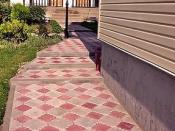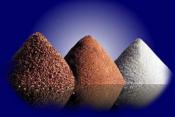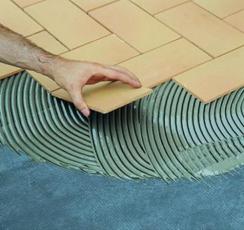Search
Login
Tile adhesive, its properties, application
In modern decoration, tiled glue is often used. Modern adhesive materials, in quality and variety, are much superior to the old. And although there is no universal glue, using which it would be possible to glue any materials, but with the right selection, nevertheless, most of the materials can be glued.
Content
- Ceramic tile adhesive
- Composition of modern tile adhesive
- Scope of tile adhesive
- Polymeric components of adhesives
- Decoding professional terms
- Estimated adhesive consumption
- Drying time
- Reasons for failed bonding
- Polymer-based grout
- Cement grout
- The method of applying cement grout
- Grout color video
Ceramic tile adhesive
Modern manufacturers make glue for ceramic tiles, both in powder form and in finished form, and some types have a dual function: they serve as glue and grout.
When laying tiles on relatively smooth surfaces, ordinary thin-layer glue is used. But there are also such adhesives, the use of which allows laying tiles on rough uneven surfaces.
For rooms with high humidity (for kitchens and bathrooms), waterproof varieties of adhesives are used, epoxy compounds prevent the formation of mold, help fight microbes.
Floor tiles are usually laid with cement-based tile adhesive. Sometimes, a thick stone tile is laid on a sand-cement mortar to which PVA adhesive additive is mixed.
Composition of modern tile adhesive
The composition of modern tile adhesive includes a cement-binding filler and modifying additives, without them a high-quality product in modern times is not possible.
Depending on which tile the adhesive is intended for, the additives also change. On a cement-sand mixture, light tiles are attached.
But modern manufacturers have established a very wide assortment: porcelain stoneware, natural stone, artificial stone and other dense and heavy materials, which it is practically impossible to fix without the use of special additives; tile adhesive Yunis 2000 and Yunis granite were widely used.
Each package contains recommendations for the installation of this type of tile.
Scope of tile adhesive
Tile adhesive is available only for interior use or for indoor and outdoor. Since basically, almost all cement-based tile adhesives are used, they can be used in wet rooms without restriction.
But if, when decorating, a complex combination of various types of tiles is used (porcelain tile, mosaic, tile), in this case, each type of material has its own adhesive.
Polymeric components of adhesives
Each manufacturer strictly guards the recipe of production, has its own secrets. But the main binder in all adhesives is the polymer component.
Most polymers are moisture resistant, but non-atmospheric resistant. When the temperature decreases, often these products lose their elastic properties and therefore are not recommended for use in freezing rooms, the price is much more expensive, therefore, in such conditions it is better to use cementitious adhesives. Clay Plus Prospectors belongs to weatherproof.
Decoding professional terms
Often in the instructions for the use of the adhesive, professional terms are indicated, such as:
- the suitability of the solution for work is the period of time counted from the moment water is added to the mixture until it begins to set. When the setting process takes place, a number of properties that are necessary are violated, in connection with this, it is necessary to prepare a certain amount of solution that can be used in a short time;
- open working time is a period of time, the report of which goes from the moment the tile adhesive was applied to the surface until the adhesive composition set, since it is not possible to fix the tile qualitatively if the adhesive has already set on it;
- the permissible correction time is a short period of time during which, after fixing the tile, you can change its position without violating the basic construction and technical properties.
Estimated adhesive consumption
Manufacturers on the packaging or in the normative documentation usually give the glue consumption. Since a too thick adhesive layer can lead to a defect, basically all adhesives are applied up to 5 mm thick.
Previously, the wall is leveled with plaster, only then the tile is glued. The larger and heavier the tile, the thicker the layer of tile adhesive.
Drying time
The usual standard tile adhesive dries within 24-48 hours and you can proceed to grouting. But specialized adhesives are also available for quick, urgent repairs, and when applied, after 3-4 hours you can grout the joints.
Reasons for failed bonding
There may be several reasons:
- the use of heavy tiles and inappropriate type of glue;
- the stacker did not firmly press the tile;
- non-compliance with the installation technology, for example, the tile is moistened with water, part of the water is absorbed into the tile, when applying the adhesive solution, it is slightly washed out and this causes insufficient adhesion;
- the open time of the adhesive is disrupted;
- dustiness of the tile or its deformation.
Polymer-based grout
This material is not often used, since it is expensive, it is better to work with this grout to a professional. Such materials are convenient, plastic, they are more dense, they do not accumulate a large amount of fungal mold.
But these grouts are toxic and if part of the grout remains on the surface of the tile, then it can only be removed mechanically, which leads to defects in the tile.
Cement grout
Cement grouts are more porous, it’s easier to work with them, but the probability of bacteria and fungus multiplying is high, in moist rooms such as a pool, special additives must be added. You can eliminate the appearance of mold when using grouts with antifungal additives.
The method of applying cement grout
Before use, it is necessary to prepare a solution, for this a dry mixture is added to the water, mixed, using a sponge or a special rubber spatula, the joints between the tiles are filled.
Using a sponge moistened with water, the surface of the grout is washed out, resulting in a glossy surface of the seam. When the grout has set, a damp rag removes the matte coating from the tile.
Grout color
The grout color is selected for the tile, it can be bright, contrast or calm, or match the color of the tile.
Often on the grout packaging, there is a transparent window through which you can see the real color.





